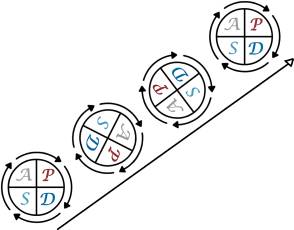Provider Toolkit
- Overview
-
The NIATx Way
- Consider a NIATx Aim
- Define a Change Project
- Appoint a Change Leader
- Appoint a Change Team
- Allocate Sufficient Resources
- Monitor Progress
- How to Perform a Walk-through
- Select a Project Aim
- Measure Baseline Data
- Select a Change Idea to Test
- Test Changes
- Increase Financial Strength
- Sustain Improvements
- Tell Your Story
- Select the Next NIATx Project
- Message to the Executive Sponsor
- Message to the Change Leader
- Sequence of Aims
- Promising Practices
- The Business Case
- Tracking and Measuring Tools
- Process Improvement Tools
- Resources
Test Changes
Use PDSA Cycles to rapidly test and refine changes.
Plan-Do-Study-Act (PDSA) is a cycle that turns a change idea into action.
It uses a series of short rapid cycles, where the goal is to test a particular change on a small scale, learn what you can, and get better in the next application. The results of each change cycle are compared to pre-test measurements to ensure that the change is actually an improvement.
Only when the change cycle results in an improvement in the existing process is the change fully implemented.

By testing changes this way, you:
- Minimize risks and expenditures of time and money
- Make changes in a way that is less disruptive to clients and staff
- Reduce resistance to change by starting on a small scale
- Learn from the ideas that work, as well as from those that do not
Thus, by starting with small changes to test ideas quickly and easily, and using simple measurements to monitor the effect of changes over time, the PDSA model can lead to larger improvements through successive quick cycles of change.
What follows is more detail about what’s involved with each phase.
PLAN the Test
Determine how you can test the change on a small scale. That means limiting the test in some way(s)—to only a few work areas or locations, particular shifts, particular types of clients, and/or for a limited period of time. Prepare a detailed plan for the test:
- Identify which staff will be involved, and dates/times for the test
- Assign responsibilities to team members
- Develop any documentation you will need (describing new procedures, for example)
- Develop data collection forms and procedures
Show the plan to your Executive Sponsor and get approval before taking action. Alert staff to when and where the tests will occur and any changes they will have to make to their regular work procedures.
DO the Test
Follow the plan as you have it outlined. If you find that you can’t do the test as planned, document any changes you have to make. Be sure to track the data before, during, and after the changes.
STUDY the Results
Start by asking questions about the data you’ve collected. What is the information telling you about change in your organization? If change is successful (meaning the data have moved in the direction you want them to move), the information you have collected may tell you which intervention had the most success in meeting your aim.
For example, one NIATx member sought to reduce the time from first contact to treatment (aim) by increasing professional staff availability. That change reduced the time from first call to first treatment from 18 days to 5 days, and in examining their data, the agency found that only physician and nurse practitioner availability played a role in the improvement. Unsuccessful changes also afford your agency the opportunity to ask “Why?”
Another NIATx member examined the characteristics of clients not continuing through the fourth treatment session and found that clients admitted to treatment on Fridays were more likely to drop out. The organization then stopped offering Friday admissions.
ACT on the New Knowledge
In the ACT step, use the results of the STUDY stage to decide on your next steps. Was the change beneficial to clients, staff, and/or the organization? Should the change be increased in scope or tested under different conditions? Should the change be adopted, adapted, or abandoned? What will be the next cycle?
REPEAT the Test
Consider what barriers you faced, what you would do differently in the future, and what went well and should be repeated. Begin a new cycle, adapting the change as needed, in order to make it a real improvement. Your changes should stay true to the PDSA cycle.
VERIFY Success
Once you have a change that the test shows is working, document those changes and their effects by updating your data charts.



